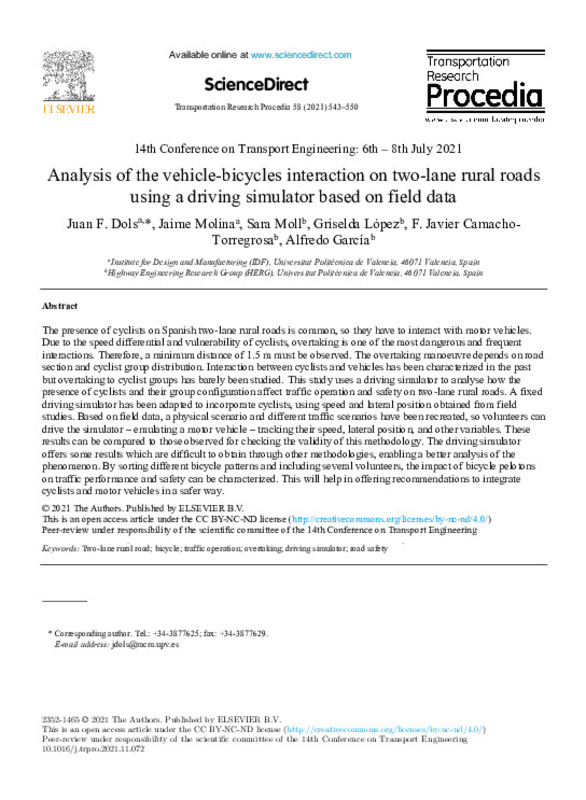|
Resumen:
|
[EN] The presence of cyclists on Spanish two-lane rural roads is common, so they have to interact with motor vehicles.
Due to the speed differential and vulnerability of cyclists, overtaking is one of the most dangerous ...[+]
[EN] The presence of cyclists on Spanish two-lane rural roads is common, so they have to interact with motor vehicles.
Due to the speed differential and vulnerability of cyclists, overtaking is one of the most dangerous and frequent
interactions. Therefore, a minimum distance of 1.5 m must be observed. The overtaking manoeuvre depends on road
section and cyclist group distribution. Interaction between cyclists and vehicles has been characterized in the past
but overtaking to cyclist groups has barely been studied. This study uses a driving simulator to analyse how the
presence of cyclists and their group configuration affect traffic operation and safety on two-lane rural roads. A fixed
driving simulator has been adapted to incorporate cyclists, using speed and lateral position obtained from field
studies. Based on field data, a physical scenario and different traffic scenarios have been recreated, so volunteers can
drive the simulator ¿ emulating a motor vehicle ¿ tracking their speed, lateral position, and other variables. These
results can be compared to those observed for checking the validity of this methodology. The driving simulator
offers some results which are difficult to obtain through other methodologies, enabling a better analysis of the
phenomenon. By sorting different bicycle patterns and including several volunteers, the impact of bicycle pelotons
on traffic performance and safety can be characterized. This will help in offering recommendations to integrate
cyclists and motor vehicles in a safer way.
[-]
|
|
Agradecimientos:
|
This study was part of a research project entitled Improvement of safety and operation of two-lane rural roads with
cyclists (Bike2Lane) (TRA 2016-8089-R) subsidized by Spanish Ministry of Science and Innovation. In addition, ...[+]
This study was part of a research project entitled Improvement of safety and operation of two-lane rural roads with
cyclists (Bike2Lane) (TRA 2016-8089-R) subsidized by Spanish Ministry of Science and Innovation. In addition, the
authors would like to thank the Road Department of the Valencian Provincial Council, and General Directorate of
Traffic of Spain, for their cooperation in field data gathering.
[-]
|









